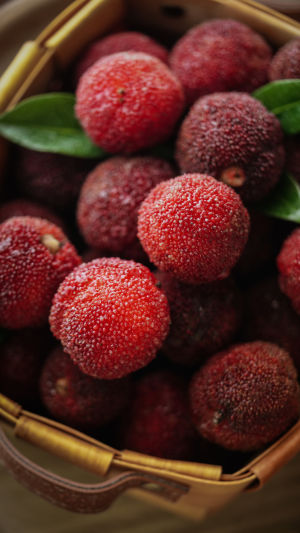Bayberry, a small fruit laden with childhood memories of summer streets, transcends its botanical identity to become a symbol rich in historical, cultural, and emotional significance.
Let's delve into the myriad charms carried by this sweet and sour little berry together.
Bayberry belongs to the Myricaceae family, Morella genus, and is an evergreen tree. It typically grows in subtropical regions and is cultivated in places like Japan and Vietnam. Bayberry fruits are spherical or elliptical, with a diameter of about 1-2 centimeters. The skin is bright red or purple-red, smooth on the surface, and the flesh is tender, juicy, and pleasantly sour-sweet, offering a unique flavor.
Historically, bayberry frequently appeared as a symbol in ancient literature, embedding itself deeply in cultural symbolism. It is imbued with meanings symbolizing friendship, innocence, and youth.
In addition to its cultural significance, bayberry also boasts rich nutritional value. It is rich in vitamin C, vitamin E, carotene, calcium, iron, and other nutrients, with antioxidant, immune-boosting, and digestive benefits, earning it the title of "grape of the south". Bayberries are versatile in the kitchen, enjoyed fresh or incorporated into various dishes. Here are some popular ways to savor bayberries:
<b>1. Fresh Consumption:</b>
Bayberry can be eaten fresh as a fruit. Simply wash and enjoy its refreshing sweet and sour taste. The juicy texture makes it particularly suitable as a cool summer fruit, perfect for quenching thirst and beating the heat.
<b>2. Juice Making:</b>
After removing the pits from the washed bayberries, blend them into juice in a blender. Add water and a little sugar to taste. This juice is refreshing and rich in vitamin C, making it a great summer cooler.
<b>3. Pickling Bayberries:</b>
Soak washed bayberries in salt water for a while, then drain and dry them. Mix with an appropriate amount of white sugar and vinegar, seal, and store for several days before consumption. Pickled bayberries have a delicious sweet and sour taste, perfect as a snack or ingredient in cold dishes.
<b>4. Bayberry Jam Making:</b>
Remove the pits from washed bayberries, add an appropriate amount of white sugar, and cook until the flesh is soft. Then blend into a paste, add a little lemon juice and water, and simmer until thickened. The resulting bayberry jam can be used to accompany bread, yogurt, ice cream, and other foods, adding a tangy sweetness.
<b>5. Bayberry Cake Making:</b>
Remove the pits from washed bayberries, add an appropriate amount of glutinous rice flour and white sugar, mix well, and steam until cooked in a steamer. Bayberry cake has a soft, sticky, sweet, and sour taste, a traditional bayberry product commonly found in some regional folk cuisines.
Whether eaten fresh or used in various delicacies, bayberry showcases its unique sweet and sour flavor and rich nutritional value, adding a touch of joy and beauty to people's lives.
However, with lifestyle changes, bayberries have gradually faded from view, becoming increasingly scarce fruits. People's tastes are also quietly changing, and this traditional fruit is no longer cherished as before.
Nevertheless, the charm of bayberries still exists. Some places have begun to attach importance to the protection and development of the bayberry industry, improving production and quality through technological means, and promoting the development of the bayberry industry. At the same time, some people are also inheriting and promoting bayberry culture by planting bayberries and making bayberry products.
Bayberry is not just a fruit but also a symbol of emotion and culture. It carries memories of childhood and conveys the beauty of friendship and youth. Let us cherish and protect this sweet and sour little berry, allowing it to continue to shine with its unique charm in the summer.





